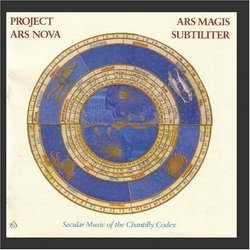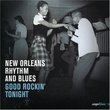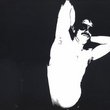| All Artists: Ensemble P.A.N. (Project Ars Nova) Title: Ars Magis Subtiliter Members Wishing: 1 Total Copies: 0 Label: New Albion Records Release Date: 11/25/2009 Genres: Special Interest, New Age, Pop, Classical Styles: Vocal Pop, Opera & Classical Vocal, Forms & Genres, Ballads, Historical Periods, Early Music Number of Discs: 1 SwapaCD Credits: 1 UPC: 022551002128 |
Search - Ensemble P.A.N. (Project Ars Nova) :: Ars Magis Subtiliter
 | Ensemble P.A.N. (Project Ars Nova) Ars Magis Subtiliter Genres: Special Interest, New Age, Pop, Classical
Ars Magis Subtiliter by Ensemble P.A.N. (Project Ars Nova) |
Larger Image |
CD DetailsSynopsis
Album Description Ars Magis Subtiliter by Ensemble P.A.N. (Project Ars Nova) Similar CDs
|
CD ReviewsIs Anybody Listening? Giordano Bruno | Wherever I am, I am. | 12/11/2008 (5 out of 5 stars) "Project Ars Nova produced five masterful recordings of Medieval music between 1989 and 1996:
*1989 - Ars Magis Subtilitor - selections from the unique Chantilly Codex *1992 - Homage to Johannes Ciconia - music by the greatest composer of the 'subtler art' *1994 - Remede de Fortune - music by Guillaume de Machaut *1994 - The Island of St. Hylarion - music from the 'crusader' kingdom of Cyprus *1996 - Angeli - earlier music by Hildegard von Bingen and other mystics It would seem that not quite enough people were listening. The ensemble has been inactive for over a decade, even though many of the key personnel are still performing. Lutenist Crawford Young is active in Europe, where I believe he teaches at the Schola Cantorum Basiliensis. Singers Laurie Monahan and Michael Collver teach at the Longy School in Boston. Shira Kammen performs freelance around the San Francisco Bay Area. Peter Becker teaches at Indiana. The sad truth is that Project Ars Nova was an ensemble of such artistry that its recordings have never been matched; such an ensemble is not likely to appear again any time soon. What would it take to bring them back? That's simple: the assurance that somebody would be listening. Composers and theorists of the 14th Century developed a system of notation far in advance of anything known before, which enabled them to notate not only pitches but extremely precise metrics - note values in relative time - of the most complicated shifting rhythms. Naturally the composers responded to such possibilities with delight, by writing fiendishly complex measured music, featuring rhythmic challenges for the singers and players that have never been surpassed. Such intellectual energy was especially valued in the Papal city of Avignon, where the musicians called their style "ars subtilior" - the subtler art. They were implicitly comparing their work to the earlier "ars nova" of Philippe de Vitry and Guillaume de Machaut. They were, in a sense, the first post-modernists. There is nothing naive or primitive about their music; it brims with experimentation and refinement. Among the composers of the ars subtilior were the members of the 'society of smokers'. Two of the pieces on this CD are 'smoking' songs; here's the text of one by Solage: Fumeux fume par fumee Fumeuse speculacion. Qu'antre fummet sa pensee Fumeux fume par fumee. Quar fumer molt li agree Tant qui'l ait son entencion Fumeux fume par fummee Fumeuse speculacion. [A smoker smokes through smoke / a smokey speculation / is his thought, between puffs / for smoking suits him well / as long as he keeps his intention ...] Smoking substances available in 14th C Avignon included hashish and opium, but not tobacco. I'll let the music of Solage's song speak for his proclivities. Virtually all the surviving music of the ars nova and ars subtilior is found in a couple of hand-copied manuscripts. Machaut in fact supervised the copying of his work into a manuscript for the ages. The Chantilly Codex is such an archive, no doubt intended to outlast its creators. The circle zodiac in the cover art of this CD is typical of the illuminations in the Codex, which includes a circular score of a circular canon by Baude Cordier - track 9, Tout par compas - and a heart-shaped score by the same composer. This was, of course, art for the performer, a global experience of beauty for the eyes and ears together. Michael Collver is the counter-tenor and cornetto muto player of Project Ars Nova. As far as I know, he's the only counter-tenor who has specialized in Medieval music. His range isn't as great as some of the Baroque male altos, but his command of rhythmic inflections is unmatched. Soprano Laurie Monahan matches him note for note in subtlety of phrasing. Their voices blend like the intertwined filagree on the margins of the Codex. The bowed string instrument played so distinctively on this CD is the vielle, the Medieval fiddle. Shira Kammen is one of a very small number of vielle-players who have taken the instrument past being a novelty to being fully expressive. Back to my first question: is any body listening? Is anybody reading? I'm thrilled to discover that this CD is still available, both new and used. I've become a self-appointed publicist, it seems, for artists like those of Project Ars Nova, in hopes that more people will listen. Lately, however, I've begun to suspect that I'm talking to myself, and my electronic scattering of words will hardly have the permanency of notes on parchment. I'll think I'll start scratching reviews on aluminum plates and burying them for the post-hominid archaeologists of the 28th Century, as far in the future as Machaut is in the past." |

 Track Listings (15) - Disc #1
Track Listings (15) - Disc #1


